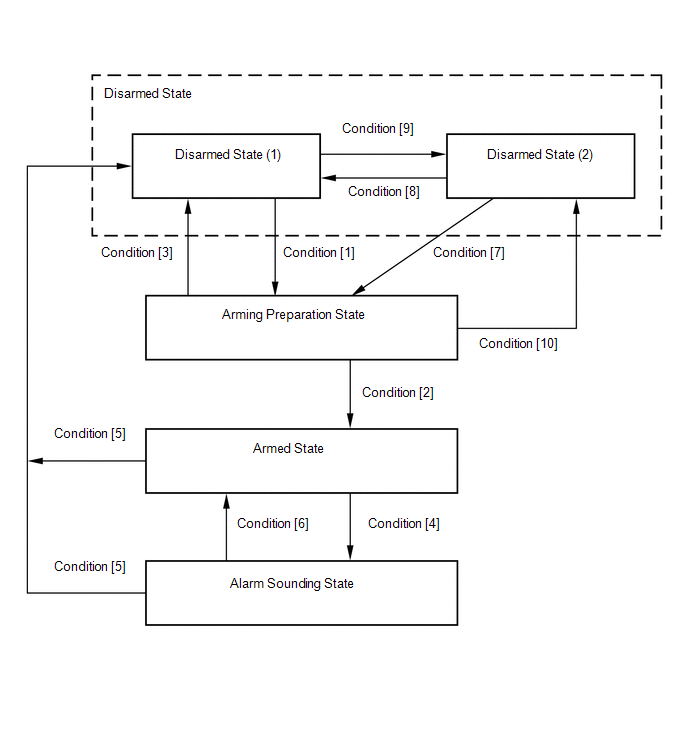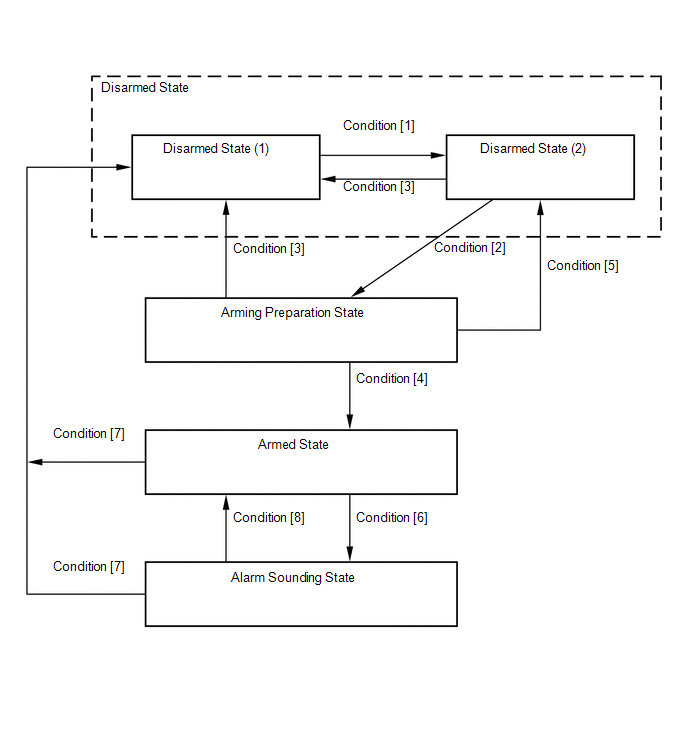- Blink when attempted break-in or theft is detected.
- Come on when theft deterrent system has entered into alarm sounding state.
| Last Modified: 08-28-2024 | 6.11:8.1.0 | Doc ID: RM100000000VJI3 |
| Model Year Start: 2016 | Model: Sienna | Prod Date Range: [12/2015 - ] |
| Title: THEFT DETERRENT / KEYLESS ENTRY: THEFT DETERRENT SYSTEM: SYSTEM DESCRIPTION; 2016 - 2020 MY Sienna [12/2015 - ] | ||
SYSTEM DESCRIPTION
1. OUTLINE OF THEFT DETERRENT SYSTEM
- The theft deterrent system can be set by locking the doors using the transmitter or key, or by opening and closing the doors (for details, refer to Active Arming Mode or Passive Arming Mode).
- The alarm function will be activated when someone attempts to forcibly unlock any of the doors or open any of the doors, engine hood and back door while the system is in the armed state.
- In the alarm sounding state, the system illuminates the interior light and blinks the hazard warning lights, the headlights and taillights. At the same time, the system sounds the vehicle horns and security horn to deter break-in and theft as well as to warn people around the vehicle.
- The alarm can be cancelled by unlocking the doors using the transmitter or key.
- There are two arming modes for this system: active arming mode and passive arming mode. When the active arming mode has been set, the theft deterrent system will be set after the user locks the doors via the transmitter or key. When the passive arming mode has been set, the theft deterrent system will be set after the key is removed and the driver door is closed.
(a) Disarmed state:
- The alarm function is not operating.
- The theft deterrent system is not operating.
(b) Arming preparation state:
- The time until the system goes into the armed state.
- The theft deterrent system is not operating.
(c) Armed state:
- The theft deterrent system is operating.
(d) Alarm sounding state:
- The alarm function is operating.
Alarm time:
Approx. 60 seconds
Alarm Methods and Time
|
Alarm Method |
Headlights |
Blinking |
|
Taillights |
Blinking |
|
|
Hazard Warning Lights |
Blinking |
|
|
Interior Light |
Illuminating |
|
|
Vehicle Horns |
Sounding (approx. 0.8 second cycles) |
|
|
Security Horn |
Sounding |
|
|
Alarm Time |
Approx. 60 seconds |
|
HINT:
- If any of the doors are unlocked when the key is not in the key cylinder*1 or the actuation area*2 during the armed state, a forced door lock signal will be output (refer to Forced Door Lock Control).
- *1: w/o Smart Key System
- *2: w/ Smart Key System
2. FUNCTION OF MAIN COMPONENTS
|
Component |
Function |
|---|---|
|
Security indicator |
Informs driver of theft deterrent system status. |
|
Security horn |
Sounds when attempted break-in or theft is detected. |
|
Headlights |
Blink when attempted break-in or theft is detected. |
|
Taillights |
|
|
Hazard warning lights |
Blink when attempted break-in or theft is detected. |
|
Interior light |
Comes on when attempted break-in or theft is detected. |
|
Vehicle horns |
Sound when attempted break-in or theft is detected. |
|
Door courtesy switch |
Detects door status (open or closed). |
|
Unlock detection switch |
Detects door status (locked or unlocked). |
|
Security courtesy switch |
Detects engine hood status (open or closed). |
|
Back door courtesy switch |
Detects back door status (open or closed). |
3. ACTIVE ARMING MODE
HINT:
Active arming mode starts the alarm control immediately after the doors are locked.
(a) Active arming mode:
This system operates as described in the diagram below when one of the items for each condition is met.

HINT:
The terms "all doors" and "any door" used in the following table include the back door.
|
Condition |
Item |
|---|---|
|
Condition [1] |
|
|
Condition [2] |
|
|
Condition [3] |
|
|
Condition [4] |
|
|
Condition [5] |
|
|
Condition [6] |
|
|
Condition [7] |
|
|
Condition [8] |
|
|
Condition [9] |
|
|
Condition [10] |
|
*1: w/o Smart Key System
*2: w/ Smart Key System
4. PASSIVE ARMING MODE
HINT:
- Passive arming mode starts the alarm control after the key is removed from the key cylinder*1 or the actuation area*2 and the doors are closed.
- Passive arming mode can be switched ON/OFF using the Techstream.
- The alarm is initially set (when shipped from the factory) to active arming mode (not passive arming mode).
- During passive arming mode, the theft deterrent system goes into the armed state even if the doors are not locked.
- Detecting that the doors are unlocked does not set off the alarm during passive arming mode.
- A forced door lock signal is not output during passive arming mode (refer to Forced Door Lock Control).
- Although the theft deterrent system detects that the doors are opened during passive arming mode, the alarm will not go off immediately because an entry delay time is set.
- If condition [1] of active arming mode is met during passive arming mode, the theft deterrent system will switch to active arming mode.
- *1: w/o Smart Key System
- *2: w/ Smart Key System
(a) Passive arming mode:
This system operates as described in the diagram below when one of the items for each condition is met.

HINT:
The terms "all doors" and "any door" used in the following table include the back door.
|
Condition |
Item |
|---|---|
|
Condition [1] |
|
|
Condition [2] |
|
|
Condition [3] |
|
|
Condition [4] |
Approx. 30 seconds elapse after condition [1] is met. |
|
Condition [5] |
|
|
Condition [6] |
|
|
Condition [7] |
|
|
Condition [8] |
Approx. 60 seconds elapse. (The alarm stops and the system returns to the armed state.) |
*1: w/o Smart Key System
*2: w/ Smart Key System
*3: When any door is opened while all doors are closed during passive arming mode, the entry delay time starts. If the switch condition (armed state → disarmed state (1) or (2)) is met during the entry delay time, the theft deterrent system will return to disarmed state (1) or (2). However, if the switch condition for disarmed state (1) or (2) is not met, the theft deterrent system will recognize it as a theft and set off the alarm. Entry delay time of 0, 14 or 30 seconds can be selected by the customizing function.
5. FORCED DOOR LOCK CONTROL
(a) The forced door lock control prevents the vehicle from being tampered with. Immediately after a door is unlocked (alarm starts), all doors are forced to lock by a forced door lock signal.
(1) Conditions that force the doors to lock:
The key is not in the key cylinder*1 or the actuation area*2 and both of the following conditions are met:
- The theft deterrent system is in the alarm sounding state of active arming mode.
- Any door is unlocked.
- *1: w/o Smart Key System
- *2: w/ Smart Key System
6. ALARM MEMORY FUNCTION
(a) If the alarm is set off (tampering is detected) while the theft deterrent system is armed, it will be stored by the alarm memory function. Whenever the theft deterrent system is cancelled, the alarm memory function causes the taillights to light up for 2 seconds in order to inform you that the alarm has been set off.
(1) Conditions that cause the taillights to light up for 2 seconds:
The theft deterrent system has entered the alarm sounding state (tampering has been detected) even once and either of the following conditions has been met:
- Switched to the disarmed state 1 from the armed state during active arming mode.
- Switched to the disarmed state 1 from the armed state during passive arming mode.
HINT:
Active arming mode: See Active Arming Mode.
Passive arming mode: See Passive Arming Mode.
7. PANIC ALARM CONTROL
(a) The panic alarm control makes it possible to voluntarily set off the panic alarm by pressing the PANIC switch on the wireless transmitter.
(1) Conditions that cause the panic alarm control to set off the panic alarm:
The PANIC switch on the wireless transmitter is pressed under the following conditions:
- The ignition switch is off.
- The theft deterrent system is not in the alarm sounding state. (This condition is common to both active arming mode and passive arming mode.)
(2) Conditions that cause the panic alarm control to shut off the alarm:
Any of the following conditions is met during panic alarm operation:
- The ignition switch is turned to ON.
- The PANIC switch is pressed again.
- Any of the switches on the wireless transmitter (LOCK/UNLOCK/POWER BACK DOOR*1/POWER SLIDE DOOR*2) is pressed.
- The panic alarm ends (approx. 60 seconds have elapsed).
- The theft deterrent system switches to the alarm sounding state. Under this condition, the theft deterrent system is controlling the alarm rather than the panic alarm control. In order to cancel this alarm, refer to the theft deterrent system alarm sounding state cancellation procedure. (This condition is common to both active arming mode and passive arming mode.)
- *1: w/ Power Back Door System
- *2: w/ Power Slide Door System
HINT:
- Active arming mode: See Active Arming Mode.
- Passive arming mode: See Passive Arming Mode.
8. SECURITY INDICATOR OUTPUT
(a) The main body ECU outputs a signal to come on the security indicator, according to the state of the theft deterrent system. However, some of the actual lighting conditions of the security indicator are different from the output signals of the main body ECU.
Output
|
State of Theft Deterrent System |
Security Indicator |
|
|---|---|---|
|
Output Signal from Main Body ECU |
Actual Lighting Condition |
|
|
Disarmed state (1), (2) |
OFF |
OFF (Immobiliser system unset) BLINKING (Immobiliser system set) |
|
Arming preparation state |
ON |
ON |
|
Armed state |
OFF |
BLINKING |
|
Alarm sounding state |
ON |
ON |
Blinking Cycle
|
Time |
Security Indicator |
|---|---|
|
0.2 second |
ON |
|
1.8 second |
OFF |
HINT:
When the immobiliser system is set, the security indicator blinks during both the disarmed state and the armed state, due to output signals from the immobiliser system.
|
|
|